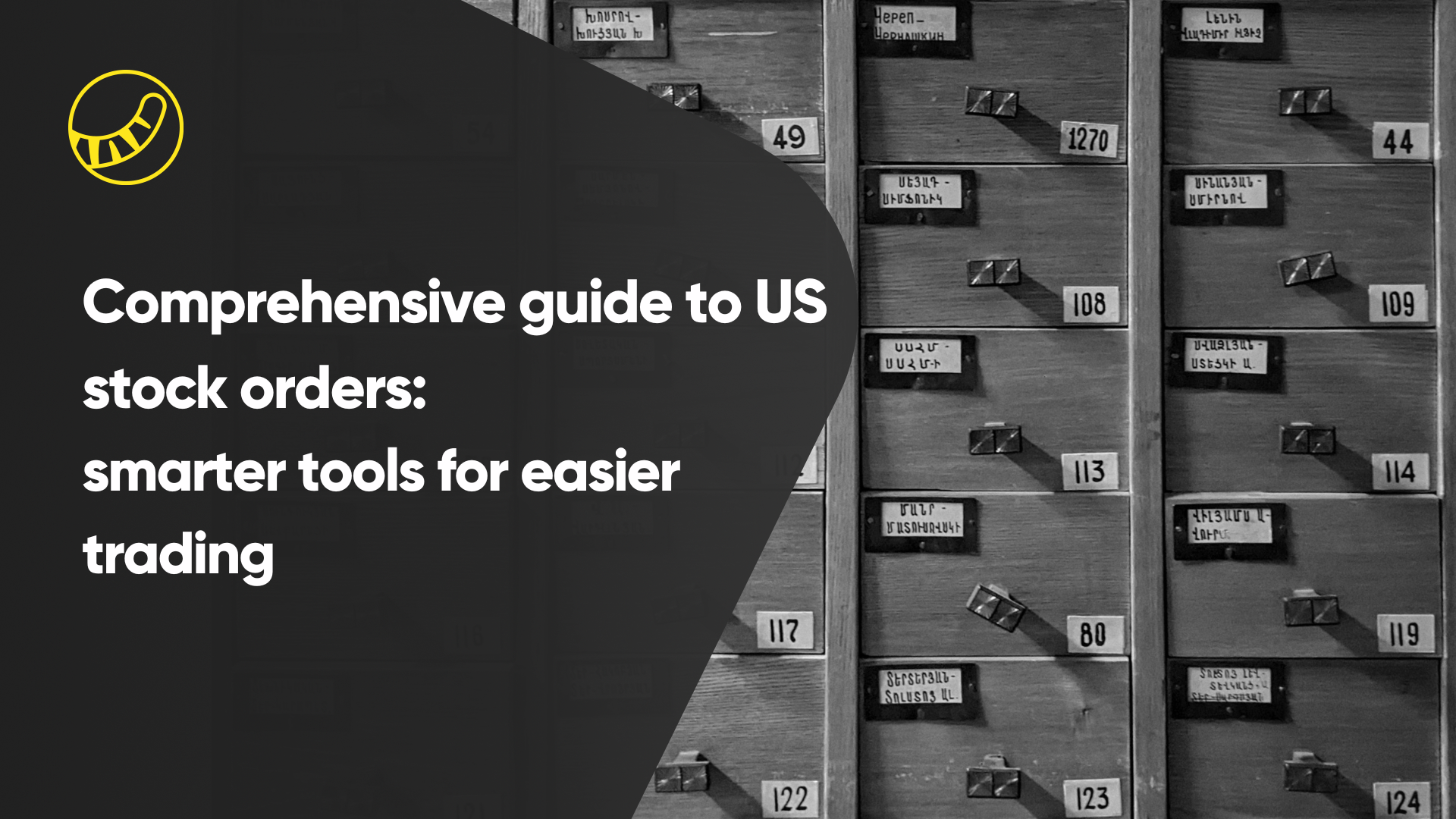Have you ever watched stock prices climb, only to miss out because your order didn’t go through? Or set a price too high, hesitated, or set it too low and failed to execute? It’s frustrating to repeatedly adjust your orders without success—especially when you miss buying the dip during a sharp drop, only to see the stock rebound shortly after.
The good news? With Tiger Trade’s versatile order types, you can navigate market fluctuations with ease. Whether you are aiming for efficiency or precision, these tools help you trade smarter and stay in control.
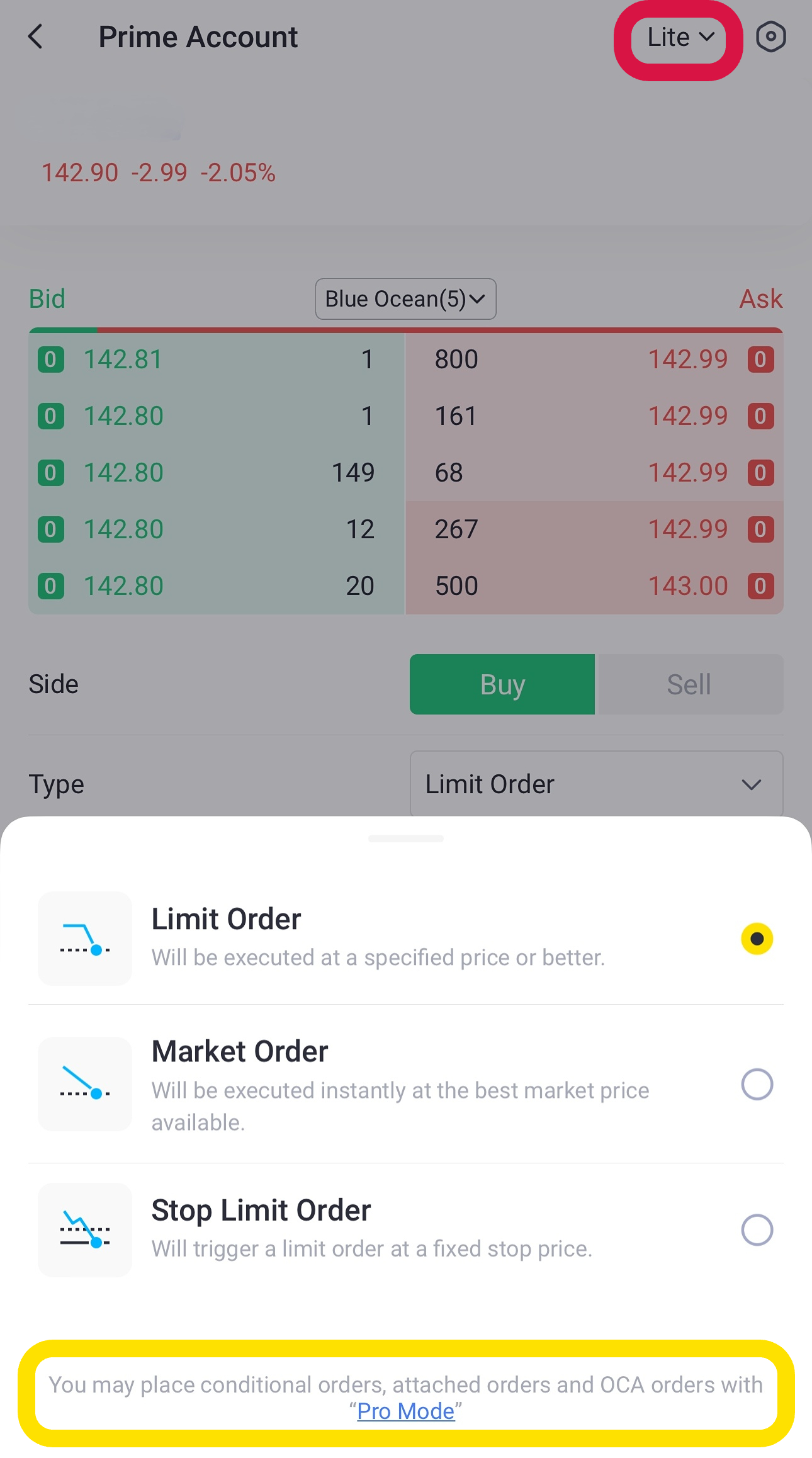
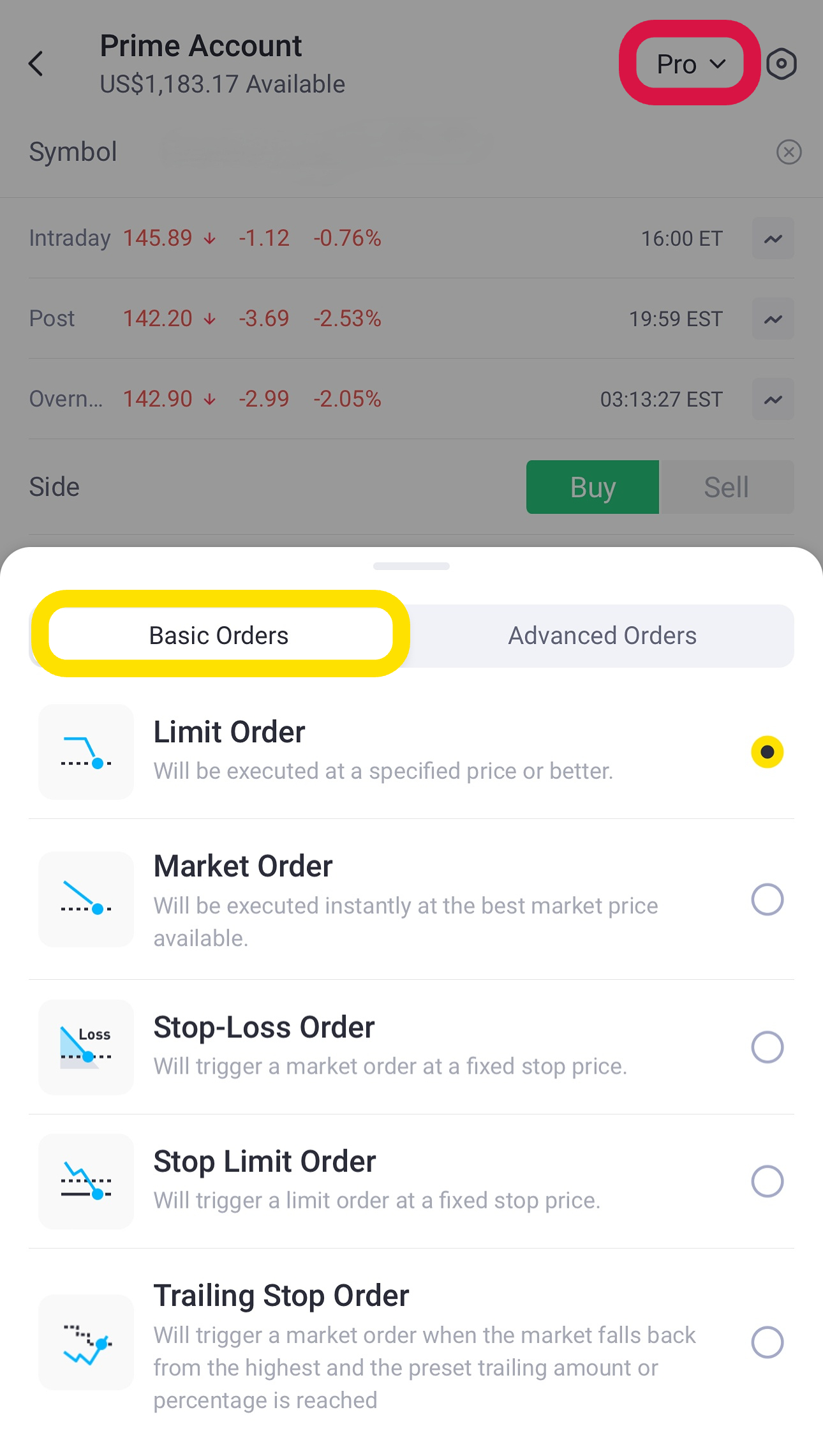
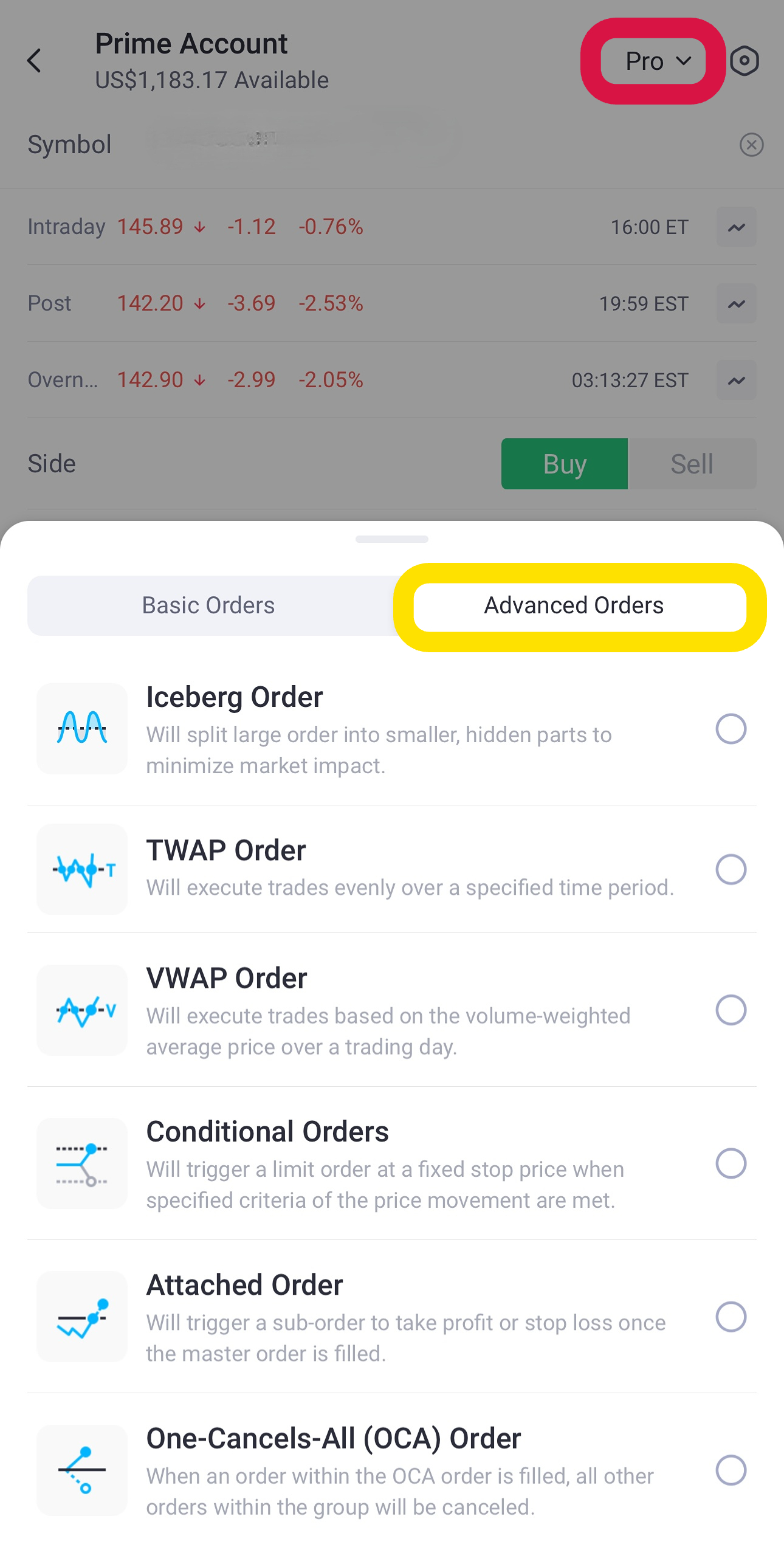
1. Limit order
What it is
A limit order lets you decide the ideal price you’re willing to pay for a stock. It’s one of the simplest and most commonly used order types in US trading because it helps you stick to your price limit without compromising on value.
When to use it
Say you’re watching Apple (AAPL), currently trading at $190, but you’re only willing to buy at $180. By placing a limit order at $180, your order will be executed if the stock reaches that price and a seller matches your bid. No need to constantly monitor the market.
With Tiger Trade, you can place limit orders for over 9,500 US stocks with 24-hour trading availability. But here’s the catch: for volatile stocks like TSLA, setting overly optimistic prices might result in your order remaining unfilled. A realistic target price can make all the difference in achieving desired trades.
How to place it
Go to the stock’s order page → Select "Limit Order" → Set your limit price → Input the quantity → Choose time in force → Select trading hours → Place the order
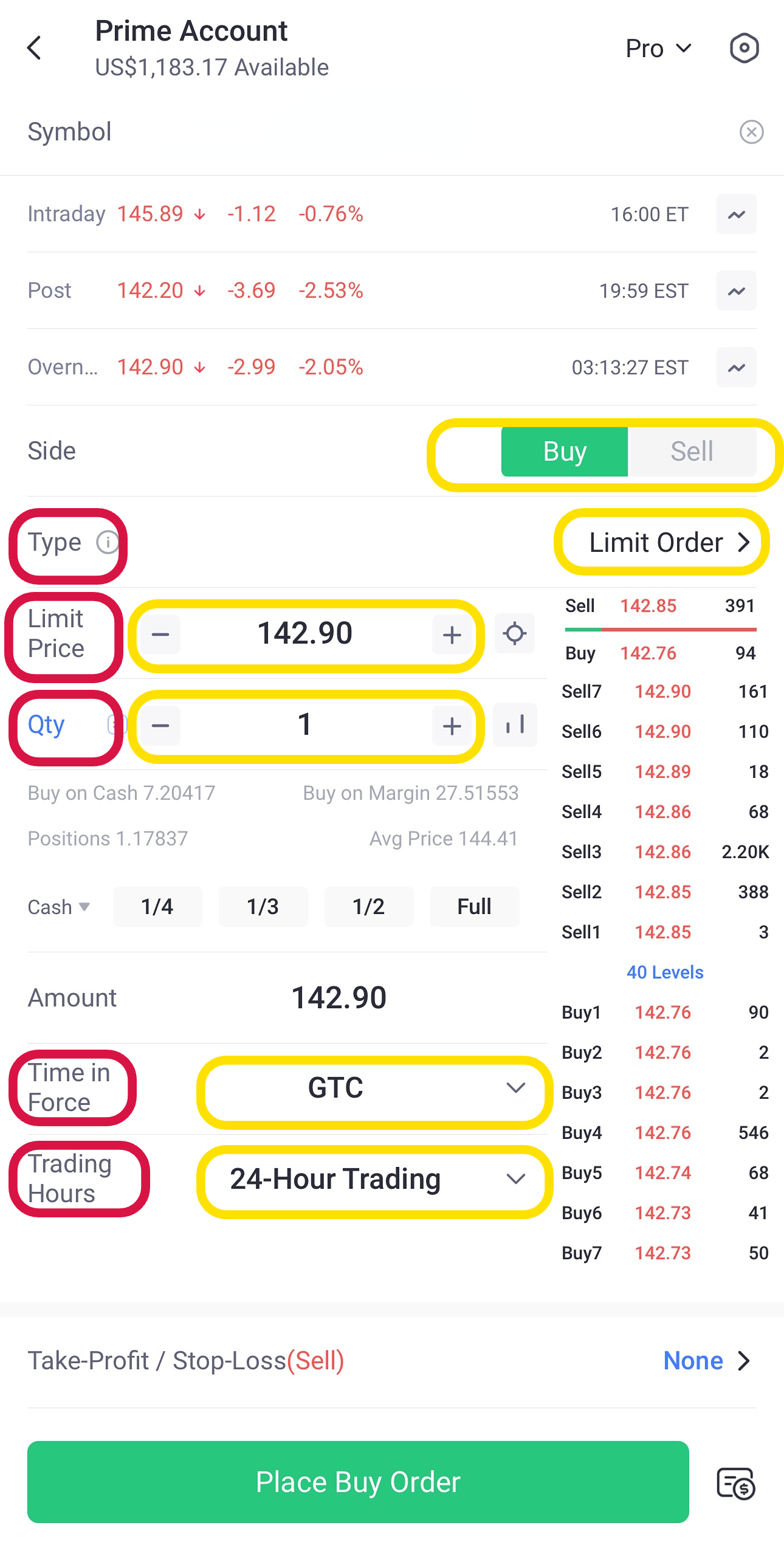
2. Market order
What it is
A market order prioritises speed over price. When you use this order type, the system will execute your trade instantly at the best available market price.
When to use it
Imagine Tesla (TSLA) has just released exciting news, and the stock is skyrocketing within minutes of the market opening. You don’t want to waste time calculating the perfect price—you want to buy in now! A market order helps you lock in your position without delay, so you don’t miss the opportunity.
However, market orders come with trade-offs. In highly volatile markets, you might not get the exact price you hoped for. For example, if you’re selling during a rapid decline, the final price that you sell at might be lower than expected. That’s why market orders are best for situations where speed is critical—not for precision-driven trades.
Also, keep in mind that while limit orders can be used during pre-market, after-hours and overnight trading sessions, market orders are only valid during regular trading hours. This restriction is designed to protect traders, as low liquidity and wide spreads outside of regular hours can lead to unfavourable execution prices.
How to place it
Go to the stock’s order page → Select "Market Order" → Input the quantity → Choose time in force → Place the order
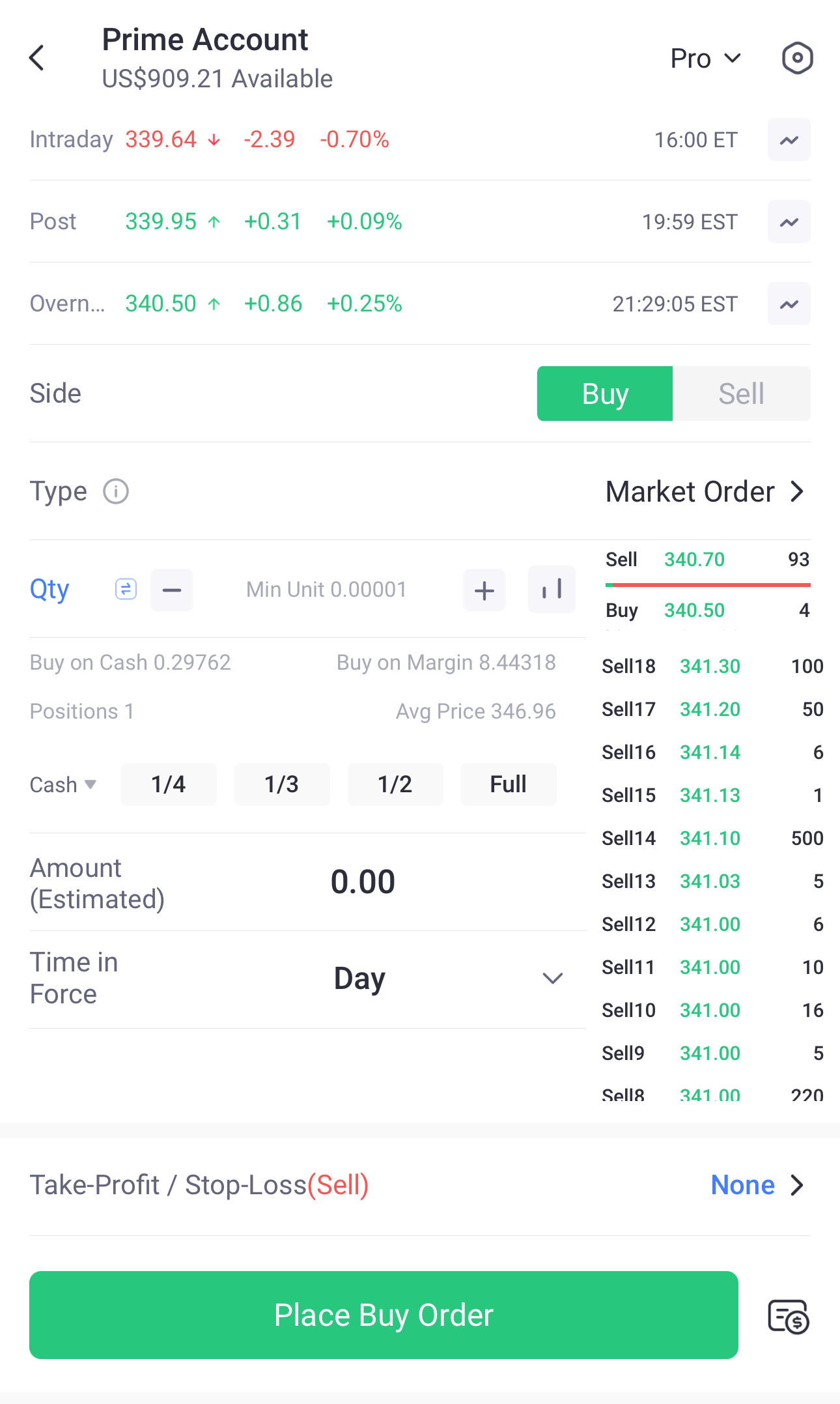
3. Stop-Loss order
What it is
A stop-loss order acts as a safety net, helping you limit losses or lock in profits. You set a trigger price, and once the stock hits that price, the system will automatically place a market buy or sell order.
When to use it
Let’s say I wish NVIDIA was trading at $430, but you want to protect yourself from a sudden price drop. You set a stop-loss order at $400. If the stock falls to $400 or below, your order is triggered, and the system sells the shares at the current market price, minimising your losses.
You can also use stop-loss orders to secure gains. If NVIDIA climbs to $500, you might adjust your stop to $470. That way, even if the price pulls back, you’ve locked in part of your profits. Just remember: markets can dip briefly before bouncing back. Setting your stop price too tight could result in unnecessary trades, so give yourself some breathing room.
How to place it
Go to the stock’s order page → Select "Stop-Loss Order" → Set your trigger price → Input the quantity → Choose time in force → Place the order
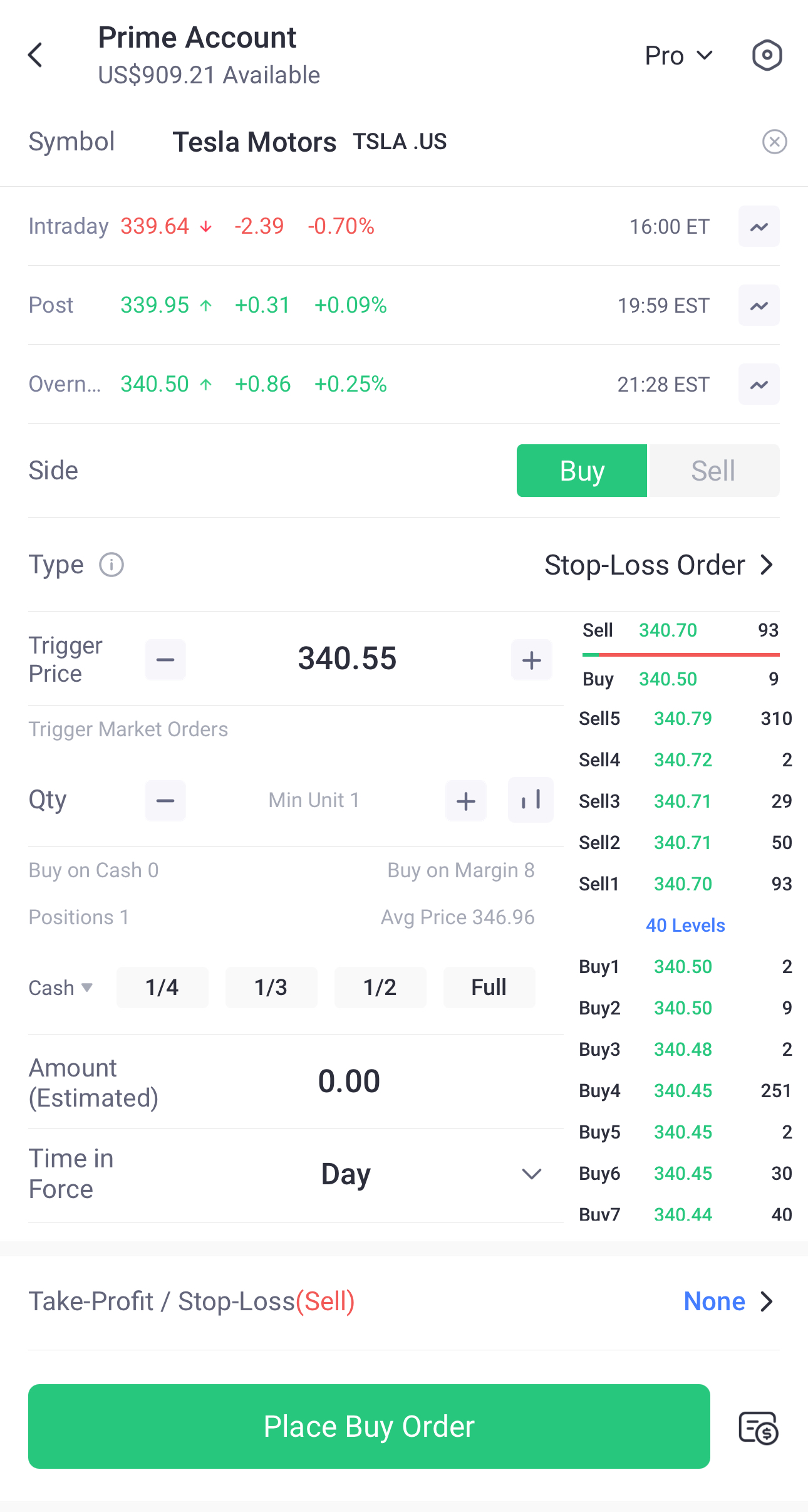
4. Stop limit order
What it is
Ever worried that your stop order might sell at a price far lower than you hoped? A stop limit order adds an extra layer of control by combining a trigger price (stop) with a specific price (limit). Once the stop price is hit, the system will only execute the trade within your chosen limit price.
When to use it
For example, NVIDIA (NVDA) is currently at $430. You want to sell if it drops to $400, but not for less than $395. With a stop limit order, you set the stop price at $400 and the limit price at $395. If the stock falls to $400, the system triggers your order and ensures it sells within the $395–$400 range.
Be cautious: if your limit range is too tight (e.g., $400–$399.99), your order might not execute in a volatile market. On the flip side, setting a wide range could increase potential losses. Striking a balance between ensuring execution and controlling risk is key.
Another perk of stop limit orders? They work in all trading sessions, unlike regular stop orders, which are only active during market hours.
How to place it
Go to the stock’s order page → Select "Stop Limit Order" → Set your stop price → Set your limit price → Input the quantity → Choose time in force → Select trading hours → Place the order

5. Trailing stop order
What it is
Think of a trailing stop order as a smarter version of the stop order. Instead of sticking to a fixed price, the trigger adjusts automatically based on how the stock moves. You can set it to follow the price either by a fixed amount or a percentage.
When to use it
Let’s say you buy a stock at $150 and set a trailing stop of $2. As the stock rises to $160, your stop price follows, moving up to $158. If the price dips back to $158, the system will sell your shares, locking in most of your gains.
You can also set a trailing percentage. If the stock hits $160 and you set a 1% trail, the system adjusts the stop to $158.40. This type of order is great for capturing profits in volatile markets while protecting against significant downturns.
That said, don’t set your trailing amount too narrowly. For example, if you set a $1 trail on a volatile stock, minor price swings could trigger a premature sale. It's better to choose a reasonable trailing distance based on the market's volatility.
How to place it
Go to the stock’s order page → Select "Trailing Stop Order" → Choose your trailing method (amount or percentage) → Set your trail → Input the quantity → Choose time in force → Place the order
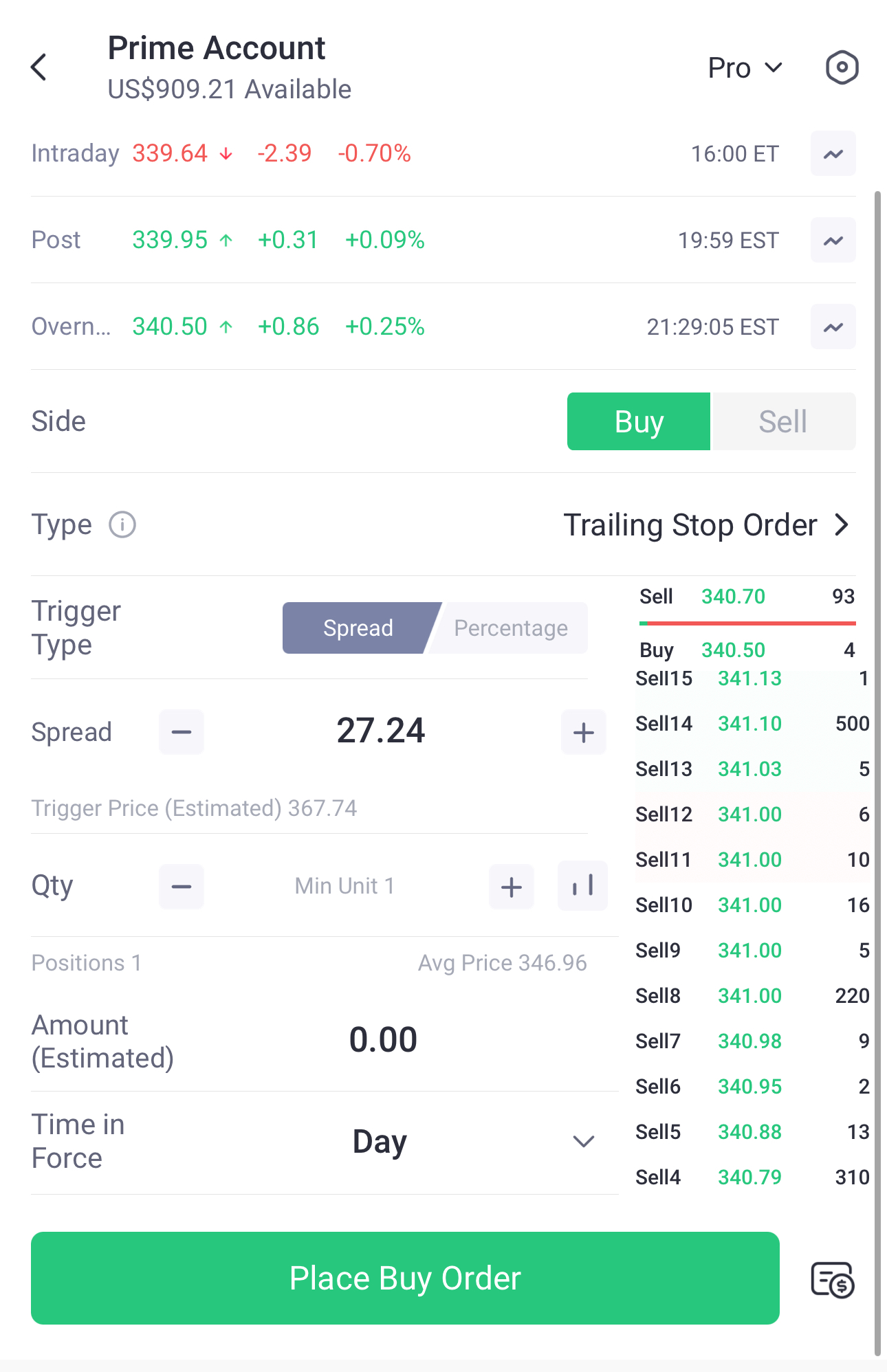
Advanced order types: unlock more trading strategies
Now that we’ve covered the five most common order types, let’s dive into three advanced ones that can take your trading to the next level.
6. Conditional order
What it is
A conditional order waits for the right moment before it kicks into action. You can set a trigger condition—like a stock reaching a specific price—and the system will automatically place a market or limit order for you.
When to use it
Imagine you want to buy Tesla (TSLA) shares if they drop below $250. In Tiger Trade, set up a Conditional Order by entering $250 as the trigger price, selecting your preferred order type (e.g., limit order), and specifying the price and quantity you want to purchase. Once confirmed, the system will track the market and automatically execute your order if TSLA drops below $250 during regular trading hours.
How to place it
Go to the stock’s order page → Select "Advanced Orders" → Choose "Conditional Order" → Set your trigger condition and price → Select the order type (market or limit) → Set order details (price and quantity) → Choose time in force → Place the order
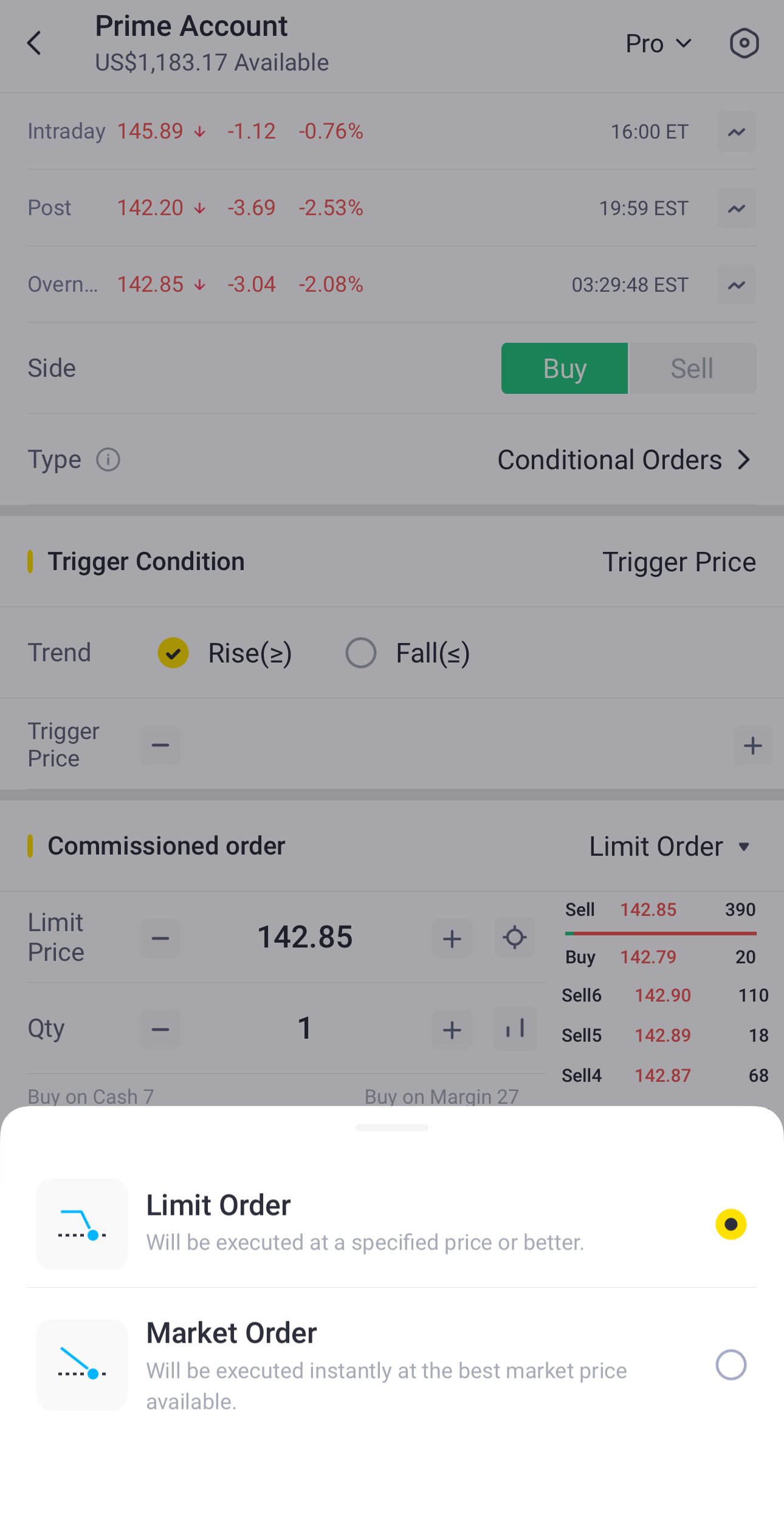
7. Attached order
What it is
An attached order gives your trade an extra layer of protection by letting you pair your main order with a follow-up plan, like a take-profit or stop-loss.
When to use it
Let’s say you want to buy a stock at $49 and sell it at $55 to lock in profits. You can set a limit order to buy at $49 and attach a take-profit order. Once the main order executes, the system will monitor the price and automatically sell when it hits $55—no manual intervention is needed.
Tiger Trade lets you customise combinations with five main order types and four attached options. Just remember: if you cancel the main order, the attached ones will also be cancelled.
How to place it
Go to the stock’s order page → Select "Advanced Orders" → Choose "Attached Order" → Set your main order → Add your attached conditions → Place the order
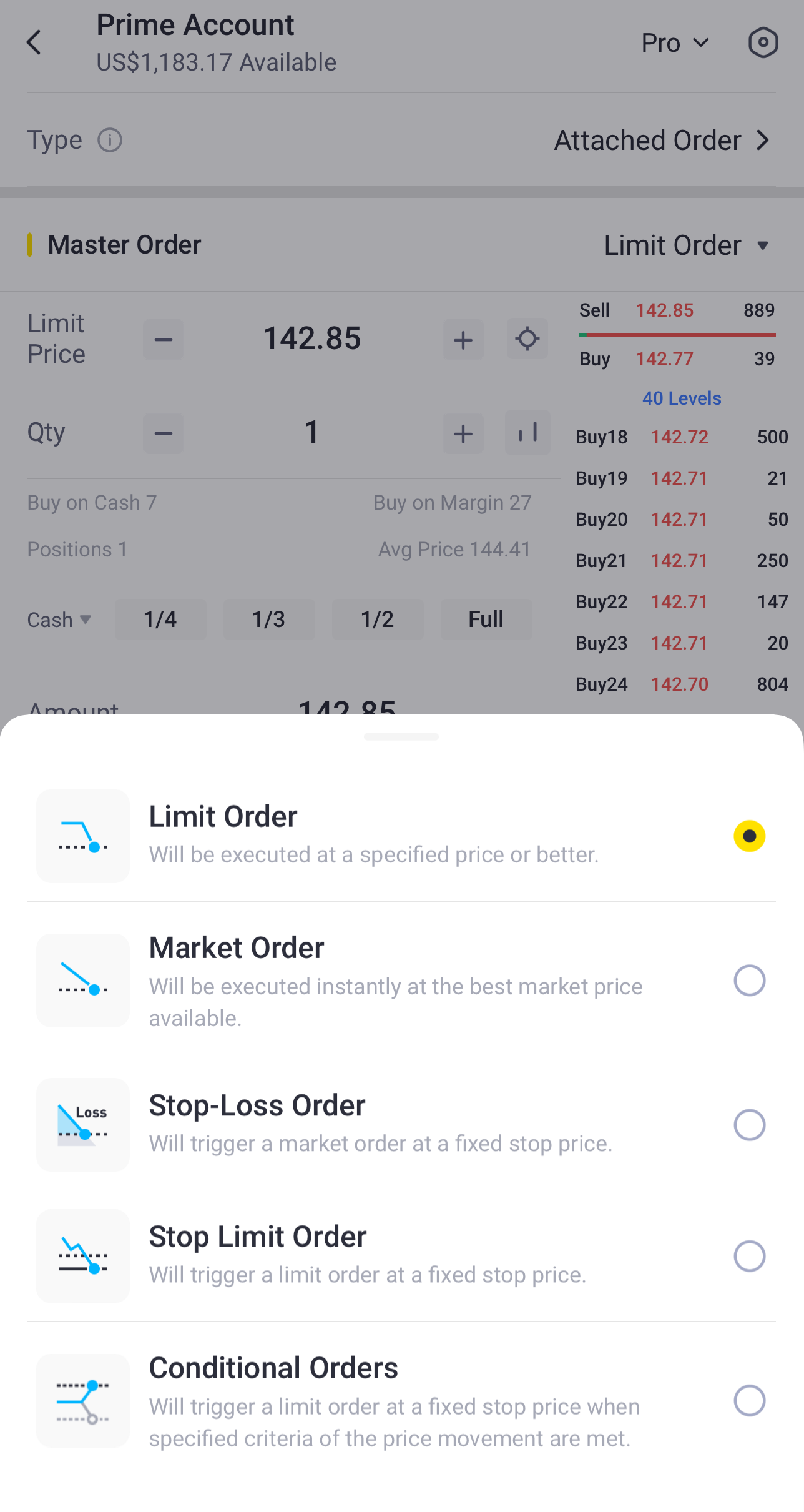
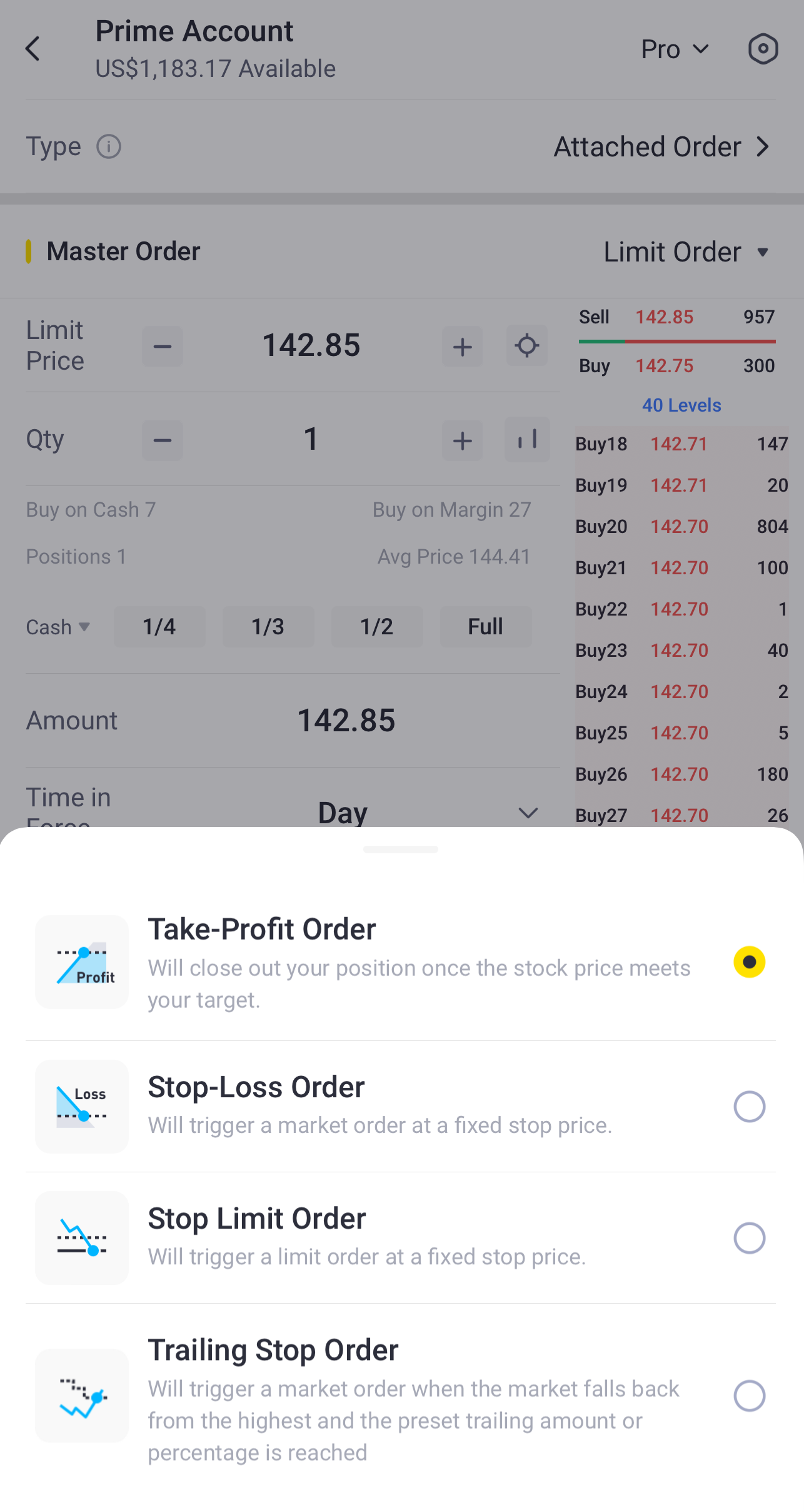
8. One-Cancels-All (OCA) order
What it is
An OCA order lets you create a group of orders where the execution of one cancels the others. It’s perfect for setting up "if this, then that" scenarios.
When to use it
For instance, you buy a stock at $100 but are unsure whether it will rise or fall. You want to sell if it hits $120 or stop the loss at $90. With an OCA order, you can set both conditions. If one triggers, the system will automatically cancel the other.
Keep in mind that funds for an OCA group are reserved based on the highest-value order, so plan your strategy accordingly.
How to place it
Go to the stock’s order page → Select "Advanced Orders" → Choose "OCA Order" → Set condition for Order 1 → Set condition for Order 2 → Place the order
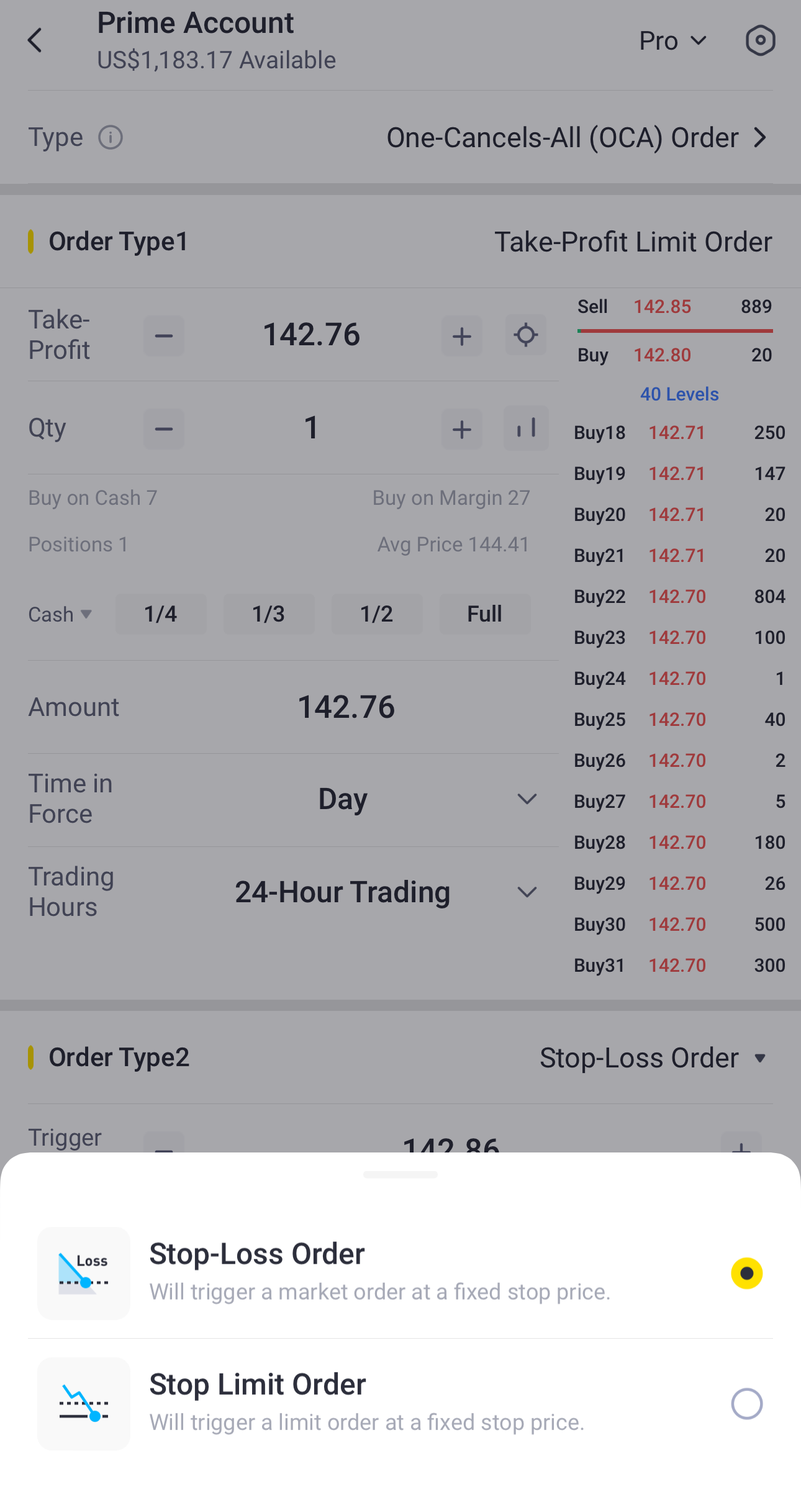
Final thoughts
From the simplicity of limit and market orders to the dynamic flexibility of advanced orders, each order type has its unique strengths. Choosing the right one can greatly enhance your trading efficiency while helping you manage risks and returns more effectively.
But remember, no trading tool is foolproof. Markets are unpredictable, and even with the best orders, there’s always a chance of slippage or unexecuted trades during volatile conditions. Tools are here to assist, but your trading plan and risk management are what truly matter. Trade smart and stay informed!
Disclaimer:Investing carries risk. This is not financial advice and should not be regarded as a solicitation or recommendation of acquiring or disposing of financial products. Any content being discussed, shared, and commented does not consider your own investment objectives or financial needs. Tiger Brokers assumes no warranty or responsibility for the accuracy and completeness of the information. Past performance is no guarantee of future results. Prices, graphics and charts are for illustrative purposes only.
This advertisement has not been reviewed by the Monetary Authority of Singapore.

